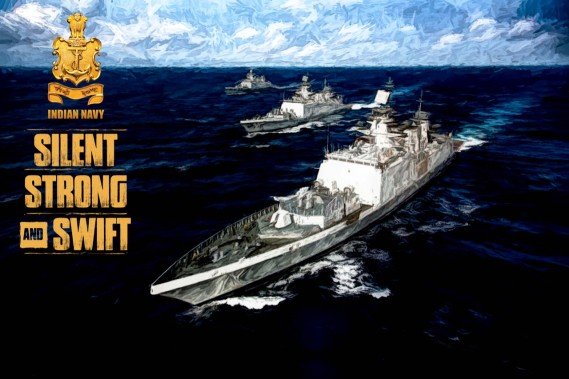The Marine Branch of the Indian Armed Forces, the Indian Navy celebrates its anniversary every year on 4th December. Ever wondered why?
Led by the President of India as Commander-in-Chief, the Indian Navy lauds December 4th to mark the Indian Navy’s Operation Trident, the attack launched by the Indian Navy on Karachi Harbour during Indo-Pakistan war that took place in the year 1971-first time when an anti-ship missile was used in the operation.
Operation Trident – How did it happen?
The enmity and outrageous behaviour broke out in its eastern front i.e. East Pakistan (now Bangladesh).
It is believed that around 3 million people died in the barbarousness and approx.
10 million people from East Pakistan crossed to the border and sought refuge in India.
When India supported east Pakistan’s liberation movement, Pakistan attacked 11 airbases in India.
The Indian retaliation included Operation Trident.
- The only link that connected the east and west Pakistan was the sea, hence India decided to strike Pakistan’s naval capability
- That time, Pakistan did not have night fighter aircraft, hence the operation was carried out after sunset
- The Indian Navy fleet sailed from Gujarat’s Okha Port towards Pakistani waters to attack the Karachi port.
- After reaching 70 miles south of Karachi at night, the navy fired missiles on Pakistani Vessel -PNS Khaibar and sank it
- The attack ravaged Pakistan’s major fuel reserves and ammunition stocks. With Operation Trident, the Indian Navy successfully sank Pakistan’s minesweeper, a destroyer, and an ammunition supply ship, and infliction of many vessels and supplies
- The Indian side included 3 Vidyut class missile warships- INS Nipat, INS Nirghat, and INS Veer, 2 anti-submarines and a tanker
- The operation killed around 500 Pakistani Navy personnel. India, on the other hand, did not suffer any loss during the operation
- Four Pakistani Vessels including cargo ship carrying ammunition were sunk by the Indian Navy’s six missiles and the Karachi harbour fuel fields in Pakistan was demolished as well
- Many Indian Navy personnel who were part of the successful operation were honoured with gallantry awards
The Operation Trident was followed by another attack by the Indian Navy, code-named Operation Python – a retaliation to Pakistan’s attempt to circumvent the Indian Navy with merchant ships.
Under Operation Python, the Indian Navy sent a strike group comprising two frigates and one missile boat that attacked a group of Pakistani vessels off the coast of Karachi.
India again did not suffer any loss in the operation and managed to damage Pakistani fleet tanker PNS Dacca beyond repair while causing them to lose the Kemari Oil Storage facility as well.
History of the Indian Navy
The Maratha Emperor, Chhatrapati Shivaji Bhonsle of the 17th century is considered as “Father of the Indian Navy”.
The theme of Navy Day 2019
The theme of Navy Day 2019 is “Indian Navy – Silent, Strong and Swift.”
Navy Day Celebrations 2019
This year Navy Day celebrations took place in Cheriya Kadamakud, Kerala – the village where the Indian Navy initiated various rehabilitation and humanitarian assistance programmes, in the aftermath of the devastating floods of August 2018, and saved 17000 lives.
Also Read: Academic Planning: Where do you see yourself in the next five years
An Overview: The Indian Navy
The Chief of the Naval Staff (CNS) exercises operational and administrative control of the Indian Navy from the Integrated Headquarters of Ministry of Defence (Navy). He is assisted by the Vice Chief of the Naval Staff (VCNS) and three other Principal Staff Officers, namely the Deputy Chief of the Naval Staff (DCNS), the Chief of Personnel (COP) and the Chief of Material (COM).
The Navy has the following three Commands, each under the control of a Flag Officer Commanding-in-Chief:-
- The Western Naval Command (Headquarters at Mumbai).
- The Eastern Naval Command (Headquarters at Visakhapatnam)
- The Southern Naval Command (Headquarters at Kochi)
The Western and the Eastern Naval Commands are ‘Operational Commands’, and exercise control over operations in the Arabian Sea and the Bay of Bengal respectively. The Southern Command is the Training Command.
The cutting edge of the Indian Navy is its two Fleets, namely the Western Fleet, based at Mumbai and the Eastern Fleet, based at Visakhapatnam.
Besides the Fleets, there is a Flotilla each, based at Mumbai, Visakhapatnam and Port Blair (A & N Islands), that provide Local Naval Defence in their respective regions.
Naval ships are also based at other ports along the East and the West coasts of India and the island territories, thus ensuring a continued naval presence in the areas of national interest.
Further, there are various Naval Officer-in-Charges (NOICs), under each Command, responsible for the Local Naval Defence of ports under their respective jurisdictions.
The defence of the Andaman & Nicobar Islands is a joint responsibility of all the three services and is coordinated by the Headquarters, Andaman & Nicobar Command, located at PortBlair.
This is the only Tri-ServicesCommand in the Indian Armed Forces and is headed by a Commander-in-Chief, as appointed in rotation from the three Services.
The Local Naval Defence of the Lakshadweep group of islands is the responsibility of the Naval Officer-in-Charge, Lakshadweep.
The fleet of #MenInWhite, the Indian Navy proudly stands as a well-balanced three-dimensional force, proficient of operating above, on and under the surface of the oceans and safeguards our national interests.
Further Reading:




